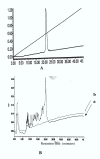Uptake of proteins and degradation of human serum albumin by Plasmodium falciparum-infected human erythrocytes
- PMID: 12801422
- PMCID: PMC161787
- DOI: 10.1186/1475-2875-2-11
Uptake of proteins and degradation of human serum albumin by Plasmodium falciparum-infected human erythrocytes
Abstract
Background: Intraerythrocytic malaria parasites actively import obligate nutrients from serum and export proteins and lipids to erythrocyte cytoplasm and membrane. The import of macromolecules in the malaria parasite has been the subject of many debates. To understand the import of macromolecules by the parasite, we studied the uptake of proteins by Plasmodium falciparum infected human erythrocyte.
Methods: Proteins were biotin labelled individually, purified on a gel filtration column and added to uninfected and infected asynchronized culture. The uptake of these proteins by malaria parasites was determined by western blot analysis of parasite pellet and their different fractions using streptavidin-horseradish conjugate. To further confirm this import, we studied the uptake of 125I-labelled proteins by western blot analysis as well as used direct immunofluorescence method.
Results: Here we show that biotin labelled and radio-iodinated polypeptides of molecular sizes in the range of 45 to 206 kDa, when added in the culture medium, get direct access to the parasite membrane through a membrane network by by-passing the erythrocyte cytosol. The import of these polypeptides is ATP-dependent as sodium azide treatment blocks this uptake. We also show that malaria parasites have the ability to take up and degrade biotin labelled human serum albumin, which has been shown to be essential for the parasite growth.
Conclusions: These results can be used, as a basis to explore the role of human serum albumin in the intraerythrocytic development of parasites, and this in turn can be an important adjunct to the development of novel antimalarial drugs.
Figures





Similar articles
-
A homologue of Sar1p localises to a novel trafficking pathway in malaria-infected erythrocytes.Eur J Cell Biol. 1999 Jul;78(7):453-62. doi: 10.1016/S0171-9335(99)80072-7. Eur J Cell Biol. 1999. PMID: 10472798
-
Methionine transport in the malaria parasite Plasmodium falciparum.Int J Parasitol. 2011 Jan;41(1):125-35. doi: 10.1016/j.ijpara.2010.09.001. Epub 2010 Sep 17. Int J Parasitol. 2011. PMID: 20851123
-
Lipid transport in Plasmodium.Infect Agents Dis. 1992 Oct;1(5):254-62. Infect Agents Dis. 1992. PMID: 1344664 Review.
-
Two-color flow cytometric analysis of intraerythrocytic malaria parasite DNA and surface membrane-associated antigen in erythrocytes infected with Plasmodium falciparum.Cytometry. 1993;14(4):449-54. doi: 10.1002/cyto.990140415. Cytometry. 1993. PMID: 8513699
-
Pexel/VTS: a protein-export motif in erythrocytes infected with malaria parasites.Trends Parasitol. 2005 Sep;21(9):396-9. doi: 10.1016/j.pt.2005.07.004. Trends Parasitol. 2005. PMID: 16046186 Review.
Cited by
-
Sphingosine 1-Phosphate in Malaria Pathogenesis and Its Implication in Therapeutic Opportunities.Front Cell Infect Microbiol. 2020 Aug 14;10:353. doi: 10.3389/fcimb.2020.00353. eCollection 2020. Front Cell Infect Microbiol. 2020. PMID: 32923406 Free PMC article. Review.
-
Recent Updates on Interaction Studies and Drug Delivery of Antimalarials with Serum Albumin Proteins.Curr Med Chem. 2024;31(25):3925-3953. doi: 10.2174/0929867330666230509121931. Curr Med Chem. 2024. PMID: 37218197 Review.
-
Development of a Multiplex Bead Assay To Detect Immunoglobulin G Antibodies to Babesia duncani in Human Serum.J Clin Microbiol. 2021 Oct 19;59(11):e0045821. doi: 10.1128/JCM.00458-21. Epub 2021 Aug 25. J Clin Microbiol. 2021. PMID: 34432487 Free PMC article.
-
The malaria parasite Plasmodium falciparum in red blood cells selectively takes up serum proteins that affect host pathogenicity.Malar J. 2020 Apr 15;19(1):155. doi: 10.1186/s12936-020-03229-1. Malar J. 2020. PMID: 32295584 Free PMC article.
-
Permselectivity and pH-dependence of Plasmodium falciparum-induced anion currents in human erythrocytes.Pflugers Arch. 2005 Aug;450(5):335-44. doi: 10.1007/s00424-005-1415-5. Epub 2005 May 21. Pflugers Arch. 2005. PMID: 15909180
References
-
- Ginsburg H, Kirk K. Membrane transport in the malaria – infected erythrocytes. In "Malaria". ASM Press, Washington DC. 1998. pp. 219–232.
-
- Sherman IW. Membrane structure and function of malaria parasites and the infected erythrocyte. Parasitology. 1985;91:606–645. - PubMed
-
- Sherman IW. Mechanism of molecular trafficking in malaria. Parasitology. 1988;96:857–881. - PubMed
Publication types
MeSH terms
Substances
LinkOut - more resources
Full Text Sources

